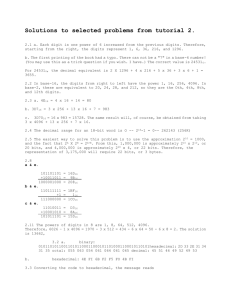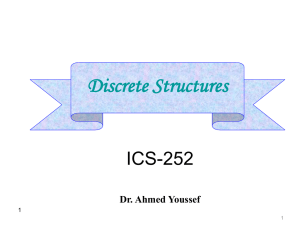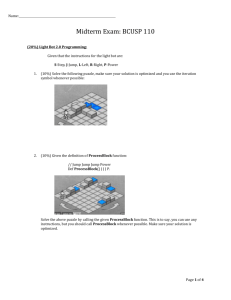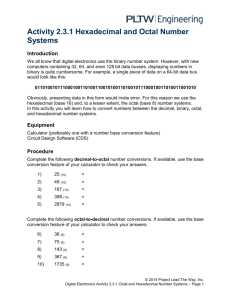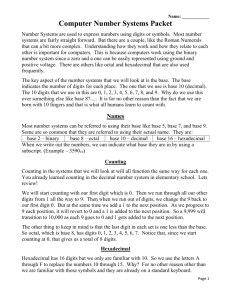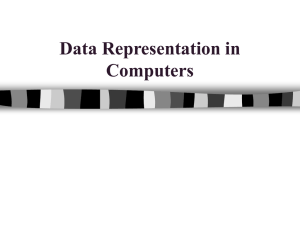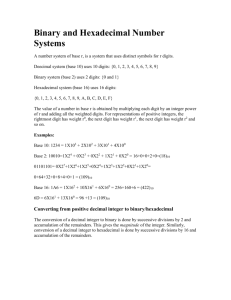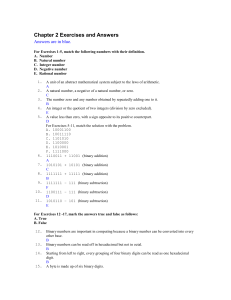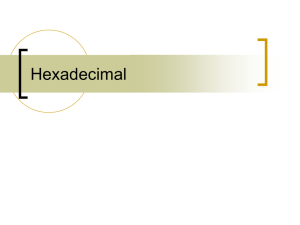number conversion
advertisement
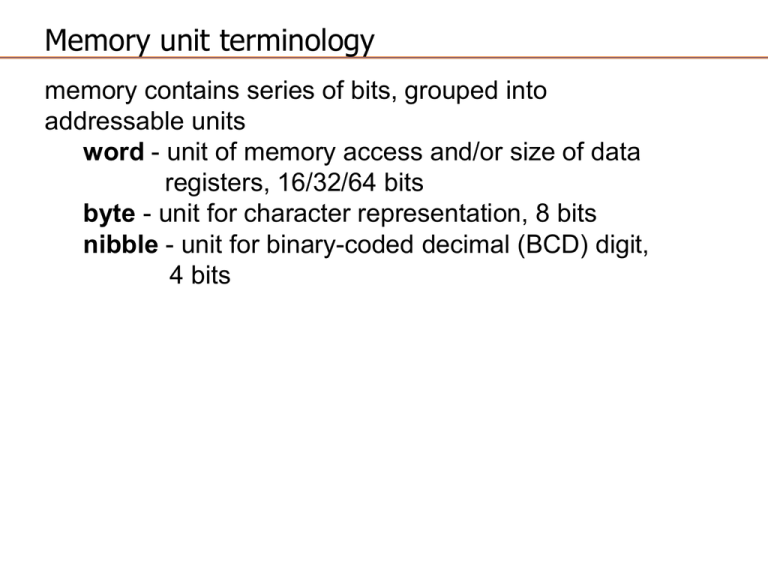
Memory unit terminology memory contains series of bits, grouped into addressable units word - unit of memory access and/or size of data registers, 16/32/64 bits byte - unit for character representation, 8 bits nibble - unit for binary-coded decimal (BCD) digit, 4 bits Binary representation and logic bit - binary digit - 0/1, off/on binary devices are relatively easy to build mathematical diversion: assume an n-state device where the cost of the device is linear in n (= kn); the number of devices required for representing an arbitrary number x is log_base_n(x); thus, the total cost to represent x is equal to kn*log_base_n(x); find the number n that minimizes this cost. (turns out to be n = e = 2.718...) n bits have 2n different patterns (permutations) unsigned integer representation = 0 to 2n - 1 Signed binary number representations Signed binary number • sign-magnitude • one's complement • two's complement Signed binary number representations sign-magnitude: sign is 0 for positive, 1 for negative di is digit, 0 <= di < b b is base (or radix) e.g. for an 8-bit representation: +5 is 00000101 +15 is 00001111 -5 is 10000101 -15 is 10001111 • Cannot simply add +5 + (-5), since that gives 10001010, which is NOT zero. o Addition and subtraction require attention to the sign bit. o If the signs are the same, add the magnitudes as unsigned numbers and watch for overflow. If the signs differ, subtract the smaller magnitude from the larger, and keep the sign of the larger. Signed binary number representations sign-magnitude: n-1 Range: +/- 2 –1 We will discuss one’s complement and two’s complement later Conversions decimal (base 10, digits 0-9) binary (base 2, digits 0,1) octal (base 8, digits 0-7) hexadecimal (base 16, digits 0-f) binary-to-decimal conversion by positional representation decimal-to-binary conversion by using remainder bits from repeated division by two Conversions 7510 = ___________2 75 /2 = 37 37/2 = 18 18/2 = 9 9/2=4 4/2=2 2/2=1 1/2=0 r r r r r r r 1 1 0 1 0 0 1 7510 = 10010112 Conversions 12110 = ________2 121 / 2 = 60 r 1 60 / 2 = 30 r 0 30 / 2 = 15 r 0 15 / 2 = 7 r 1 7 / 2 = 3 r 1 3 / 2 = 1 r 1 1 / 2 =0 r 1 12110 = 11110012 How do we convert to octal? hexadecimal? 12110 = 11110012 11110012 = 001 111 0012 = 1718 11110012 = 0111 10012 = 7916 Conversions binary-to-hexadecimal and back using a table organize the stream of binary digits into groups of four. find the hexadecimal value for each group of 4 bits. 10010010111000011010 1001 0010 1110 0001 1010 9 2 E 1 A hexadecimal-to-binary convert each digit to its 4-bit equivalent 9 2 E 1 A 1001 0010 1110 0001 1010 Conversions conversion from binary-to-octal and octal-to-binary in a similar manner: simply organize the stream of binary digits into groups of three. 10 010 010 111 000 011 010 2 2 2 7 0 3 2 similar conversions between decimal and other bases, but typically decimal is first converted to binary then to octal or hex Conversions gdb conversions p/d 0x123 -- print as decimal, passing a hexadecimal constant p/x 123 -- print as hexadecimal, passing a decimal constant p/t 123 -- print as binary, passing a decimal constant (note that a leading zero is significant to gdb, 0123 is taken as octal) Character encoding - ASCII Conversions Magic numbers numbers that read as English words/phrases when displayed in hexadecimal - catch uninitialized variables / bad pointers 0xdeadbeef, 0xbaadf00d - identify file type - 0xcafebabe in Java class file - typically chosen to be a large, negative, odd integer (and thus unlikely to be a useful program constant) (see en.wikipedia.org/wiki/Hexspeak) Binary Logic a 0 not 1 1 0 a 0 0 0 1 b 0 1 1 1 ARM opcode description --------- -------------false and a and b bic a and (not b) a b and (not a) b eor a xor b orr a or b and 0 0 0 1 a 0 0 0 1 b 0 1 1 1 a=0011 b=0101 ------------0000 0001 0010 0011 0100 0101 0110 0111 or 0 1 1 1 a 0 0 0 1 b 0 1 1 1 xor 0 1 1 0 some common names --------------------------false, zero, clear and and-not, inhibit, a>b a inhibit, a<b b xor, exclusive or, a!=b or, inclusive or iff, xnor, exclusive nor Binary Logic Logic operators in C: && and || or ! not (zero word = false, nonzero word = true) Bitwise operators in C: & and (each bit in word independent) | or ~ not ^ xor Logic operators in ARM assembly language: and[cc] bic[cc] eor[cc] orr[cc]
